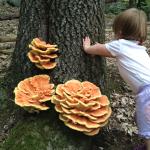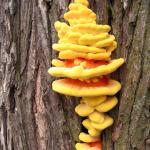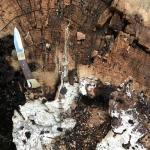Root and Butt Rot caused by Laetiporus cincinnatus & L. sulphureus (Chicken of the Woods)
Pathogen
The native fungal pathogens Laetiporus cincinnatus & L. sulphureus are known as chicken of the woods.
Hosts
Both Laetiporus cincinnatus and L. sulphureus are primarily found on oaks (Quercus spp.) in southern New England. However, both pathogens are capable of attacking a variety of other hardwoods, including maple (Acer) and beech (Fagus) (Luley 2022, Sinclair and Lyon 2005).
Symptoms & Signs
Laetiporus species cause a brown rot in infected wood tissues, decaying the cellulose and hemicellulose while the lignin remains in an altered form (Schwarze et al. 2000). The decay is often concentrated in the heartwood and slowly expands out towards the margins into live sapwood. Because the cellulose is preferentially decayed, brown rot leads to dramatic reductions in wood bending strength. Trees with advanced infections may be susceptible to uprooting or stem failure under loading from strong winds (Schwartze et al. 2000, Luley 2022). Because Laetiporus speciesattack the heartwood, extensive decay may be present with no external symptoms, as the sapwood remains largely unaffected until the late stages of decay. When the decay is advanced, white-colored strands or sheets of fungal mycelia may be embedded within the infected wood tissue. General canopy decline and dieback symptoms may be present along with more overt symptoms of butt rot, such as excessive basal tapering.
The annual, fleshy fruiting bodies produced by Laetiporus are yellowish-orange to bright orange and appear anytime from July into October. Across southern New England, they are often observed from late July through late August. While L. cincinnatus and L. sulphureus are very similar, they do exhibit distinguishing features. Specifically, fruiting bodies produced by L. cincinnatus have an upper surface that is orange with a white margin (pileus) and white pore layer on the underside (hymenium) that develops in a rosette pattern. They grow adjacent to the trunk at the soil line or from infected roots several feet away from the base of the tree (Burdsall and Banik 2001). Fruiting bodies produced by L. sulphureus have an upper surface that is yellow-orange with a yellow margin (pileus) and a yellow pore layer on the underside (hymenium). They often develop in overlapping shelves growing directly on the root flare or main trunk. In general, decay in the roots and lower trunk appears to be more common with L. cinncinatus while decay in the lower and upper trunk is more common with L. sulphureus (Burdsall and Banik 2001, Luley 2022). The presence of fruiting bodies frequently indicates that extensive decay is present in either the roots or trunk of infected oaks.
Laetiporus sulphureus is reported as more common in the northeast in comparison to L. cincinnatus (Luley 2022). However, a survey of herbarium specimens suggests the two species are equally as common throughout their range (Burdsall and Banik 2001). Because symptoms of infection are often absent, fruiting bodies of L. sulphureus may be more conspicuous and persist longer as they develop on the trunk of infected trees. Meanwhile, fruiting bodies of L. cincinnatus may develop several feet away from the tree where they may be destroyed by lawn mowers or are unable to penetrate through hardscapes in urban settings.
Management
Laetiporus is one of the most important wood-decaying fungal pathogens of trees in Massachusetts. Trees with fruiting bodies should receive a thorough tree risk assessment. Minimally invasive decay detection techniques, such as resistance drilling or sonic tomography, can be conducted to determine the location and severity of the decay. Document the location and number of fruiting bodies with photos, as these can be used to identify between the two species. As with any tree infected by a root and butt rot pathogen, maintaining high tree vigor is important. If annual increment growth can keep pace with the rate of decay in the heartwood, this may reduce the risk of failure. Maintain a large ring of mulch or wood chips around the tree and manage insect pests and pathogens that can weaken the tree. Improving soil quality may also increase vigor. Pruning to reduce canopy sway can also be performed.
References
Burdsall, HH and Banik, MT. 2001. The genus Laetiporus in North America. Harvard Papers in Botany 6(1): 43–55.
Luley, CJ. 2022. Wood Decay Fungi Common to the Northeast & Central United States, 2nd Edition. Urban Forest Diagnostics LLC, Naples, NY.
Schwarze FWMR, Engels J, and Mattheck C. 2000. Fungal Strategies of Wood Decay in Trees. Springer, Berlin, Germany.
Sinclair WA and Lyon, HH. 2005. Diseases of Trees and Shrubs, 2nd edn. Cornell University Press, Ithaca, NY.





